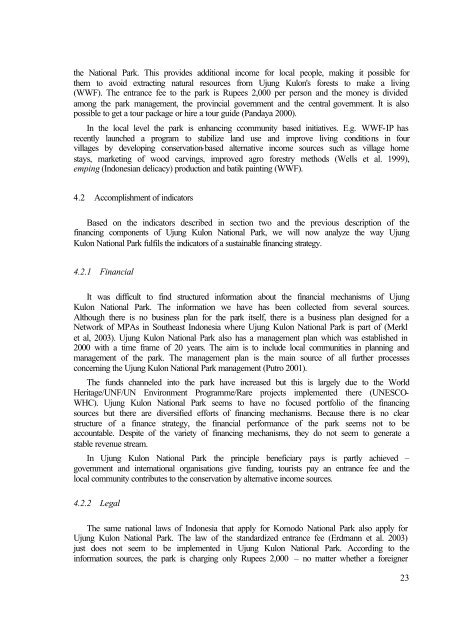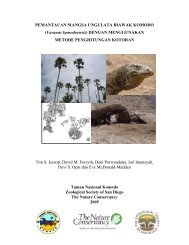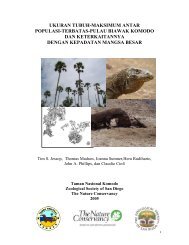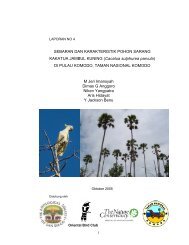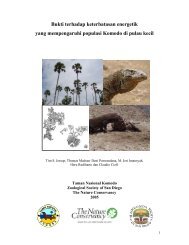Sustainable Financing of MPAs - Komodo National Park
Sustainable Financing of MPAs - Komodo National Park
Sustainable Financing of MPAs - Komodo National Park
Create successful ePaper yourself
Turn your PDF publications into a flip-book with our unique Google optimized e-Paper software.
the <strong>National</strong> <strong>Park</strong>. This provides additional income for local people, making it possible for<br />
them to avoid extracting natural resources from Ujung Kulon's forests to make a living<br />
(WWF). The entrance fee to the park is Rupees 2,000 per person and the money is divided<br />
among the park management, the provincial government and the central government. It is also<br />
possible to get a tour package or hire a tour guide (Pandaya 2000).<br />
In the local level the park is enhancing ccommunity based initiatives. E.g. WWF-IP has<br />
recently launched a program to stabilize land use and improve living conditions in four<br />
villages by developing conservation-based alternative income sources such as village home<br />
stays, marketing <strong>of</strong> wood carvings, improved agro forestry methods (Wells et al. 1999),<br />
emping (Indonesian delicacy) production and batik painting (WWF).<br />
4.2 Accomplishment <strong>of</strong> indicators<br />
Based on the indicators described in section two and the previous description <strong>of</strong> the<br />
financing components <strong>of</strong> Ujung Kulon <strong>National</strong> <strong>Park</strong>, we will now analyze the way Ujung<br />
Kulon <strong>National</strong> <strong>Park</strong> fulfils the indicators <strong>of</strong> a sustainable financing strategy.<br />
4.2.1 Financial<br />
It was difficult to find structured information about the financial mechanisms <strong>of</strong> Ujung<br />
Kulon <strong>National</strong> <strong>Park</strong>. The information we have has been collected from several sources.<br />
Although there is no business plan for the park itself, there is a business plan designed for a<br />
Network <strong>of</strong> <strong>MPAs</strong> in Southeast Indonesia where Ujung Kulon <strong>National</strong> <strong>Park</strong> is part <strong>of</strong> (Merkl<br />
et al, 2003). Ujung Kulon <strong>National</strong> <strong>Park</strong> also has a management plan which was established in<br />
2000 with a time frame <strong>of</strong> 20 years. The aim is to include local communities in planning and<br />
management <strong>of</strong> the park. The management plan is the main source <strong>of</strong> all further processes<br />
concerning the Ujung Kulon <strong>National</strong> <strong>Park</strong> management (Putro 2001).<br />
The funds channeled into the park have increased but this is largely due to the World<br />
Heritage/UNF/UN Environment Programme/Rare projects implemented there (UNESCO-<br />
WHC). Ujung Kulon <strong>National</strong> <strong>Park</strong> seems to have no focused portfolio <strong>of</strong> the financing<br />
sources but there are diversified efforts <strong>of</strong> financing mechanisms. Because there is no clear<br />
structure <strong>of</strong> a finance strategy, the financial performance <strong>of</strong> the park seems not to be<br />
accountable. Despite <strong>of</strong> the variety <strong>of</strong> financing mechanisms, they do not seem to generate a<br />
stable revenue stream.<br />
In Ujung Kulon <strong>National</strong> <strong>Park</strong> the principle beneficiary pays is partly achieved –<br />
government and international organisations give funding, tourists pay an entrance fee and the<br />
local community contributes to the conservation by alternative income sources.<br />
4.2.2 Legal<br />
The same national laws <strong>of</strong> Indonesia that apply for <strong>Komodo</strong> <strong>National</strong> <strong>Park</strong> also apply for<br />
Ujung Kulon <strong>National</strong> <strong>Park</strong>. The law <strong>of</strong> the standardized entrance fee (Erdmann et al. 2003)<br />
just does not seem to be implemented in Ujung Kulon <strong>National</strong> <strong>Park</strong>. According to the<br />
information sources, the park is charging only Rupees 2,000 – no matter whether a foreigner<br />
23


